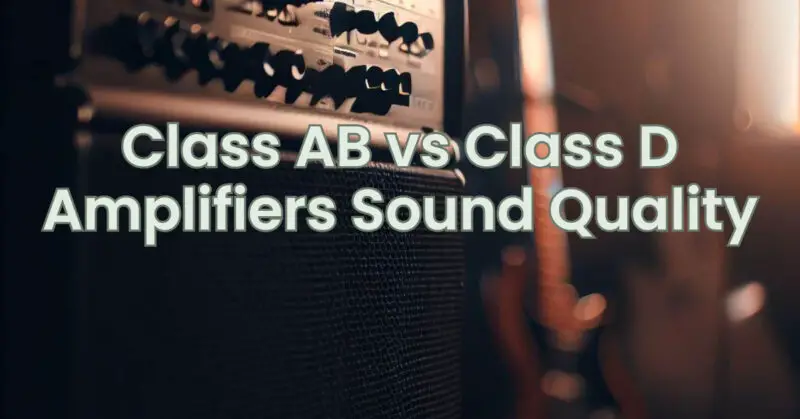When it comes to audio amplification, selecting the right amplifier is essential to achieve optimal sound quality. Two popular amplifier classes that often enter the debate are Class AB and Class D amplifiers. In this article, we will explore the sound quality characteristics of these amplifier classes and understand the differences between them.
Class AB Amplifiers: Class AB amplifiers are known for their analog operation and are commonly used in audio applications. They employ a combination of Class A and Class B amplification techniques. Class AB amplifiers have two active devices (transistors), one conducting for positive signal swings and the other for negative signal swings. This configuration allows for efficient power usage while reducing distortion.
Sound Quality of Class AB Amplifiers: Class AB amplifiers are generally praised for their excellent sound quality. They provide a relatively low level of distortion compared to other amplifier classes. The crossover distortion, which occurs when the audio signal transitions between the positive and negative halves of the waveform, is significantly minimized in Class AB amplifiers. This reduction in distortion results in clearer, more accurate sound reproduction, making Class AB amplifiers a popular choice for high-fidelity audio applications.
Advantages of Class AB Amplifiers:
- Low Distortion: Class AB amplifiers offer low levels of distortion due to their biasing techniques, resulting in faithful audio reproduction.
- Smooth Transitions: The transition between positive and negative signal swings is relatively seamless, reducing audible artifacts.
- Widely Available: Class AB amplifiers have been widely used and developed over the years, resulting in a mature technology with a broad range of options available in the market.
- Suitable for Wide Frequency Range: Class AB amplifiers are well-suited for applications that require accurate sound reproduction across a wide frequency range, making them popular for music and high-quality audio systems.
Class D Amplifiers: Class D amplifiers, on the other hand, operate using a different principle known as pulse-width modulation (PWM). They switch the input audio signal rapidly on and off at a high frequency to generate a series of pulses. These pulses are then filtered to reconstruct the original audio signal. Class D amplifiers are highly efficient, compact, and capable of delivering high power output.
Sound Quality of Class D Amplifiers: Traditionally, Class D amplifiers have been associated with lower sound quality due to inherent distortion caused by the switching operation. However, advancements in technology and design have greatly improved the sound quality of Class D amplifiers over the years. Modern Class D amplifiers can offer audio reproduction that is comparable to Class AB amplifiers in many scenarios.
Advantages of Class D Amplifiers:
- High Efficiency: Class D amplifiers are highly efficient, meaning they waste less power as heat, resulting in cooler operation and reduced power consumption.
- Compact Size: Class D amplifiers are typically smaller and lighter than Class AB amplifiers, making them suitable for portable and space-constrained applications.
- Power Handling: Class D amplifiers can handle high power output with ease, making them suitable for demanding audio systems such as subwoofers and PA systems.
- Cost-Effective: Due to their efficiency and simpler circuitry, Class D amplifiers can often be more cost-effective than Class AB amplifiers.
Both Class AB and Class D amplifiers have their merits when it comes to sound quality. Class AB amplifiers are renowned for their low distortion and accurate sound reproduction, making them a preferred choice for high-fidelity audio systems. On the other hand, Class D amplifiers offer high efficiency, compact size, and cost-effectiveness, with modern designs significantly improving their sound quality. The choice between the two ultimately depends on the specific requirements of the application, considering factors such as power demands, size constraints, and budget. By understanding the characteristics and trade-offs of each amplifier class, audio enthusiasts can make informed decisions to achieve the desired sound quality in their setups.

